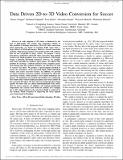Data Driven 2-D-to-3-D Video Conversion for Soccer
Author(s)
Calagari, Kiana; Elgharib, Mohamed; Didyk, Piotr; Kaspar, Alexandre; Matusik, Wojciech; Hefeeda, Mohamed; ... Show more Show less
DownloadAccepted version (5.716Mb)
Terms of use
Metadata
Show full item recordAbstract
© 1999-2012 IEEE. A wide adoption of 3-D videos is hindered by the lack of high-quality 3-D content. One promising solution to this problem is through data-driven 2-D-To-3-D video conversion. Such approaches are based on learning depth maps from a large dataset of 2-D+Depth images. However, current conversion methods, while general, produce low-quality results with artifacts that are not acceptable to many viewers. We propose a novel, data-driven method for 2-D-To-3-D video conversion. Our method transfers the depth gradients from a large database of 2-D+Depth images. Capturing 2-D+Depth databases, however, are complex and costly, especially for outdoor sports games. We address this problem by creating a synthetic database from computer games and showing that this synthetic database can effectively be used to convert real videos. We propose a spatio-Temporal method to ensure the smoothness of the generated depth within individual frames and across successive frames. In addition, we present an object boundary detection method customized for 2-D-To-3-D conversion systems, which produces clear depth boundaries for players. We implement our method and validate it by conducting user studies that evaluate depth perception and visual comfort of the converted 3-D videos. We show that our method produces high-quality 3-D videos that are almost indistinguishable from videos shot by stereo cameras. In addition, our method significantly outperforms the current state-of-The-Art methods. For example, up to 20% improvement in the perceived depth is achieved by our method, which translates to improving the mean opinion score from good to excellent.
Date issued
2018Department
Massachusetts Institute of Technology. Computer Science and Artificial Intelligence LaboratoryJournal
IEEE Transactions on Multimedia
Publisher
Institute of Electrical and Electronics Engineers (IEEE)